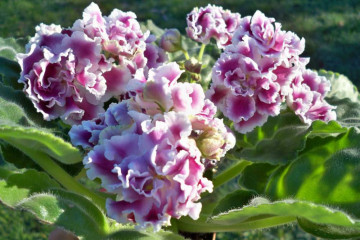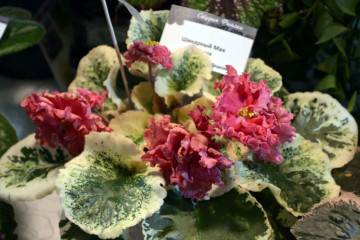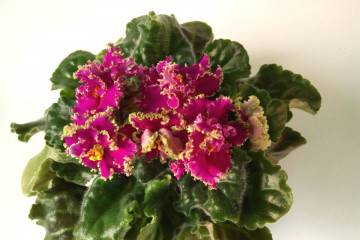Violet Ice Rose - description and characteristics of the variety
Content:
Violet RS-Ice Rose attracts not only with large double flowers with a spectacular border, but also with ease of care. This charming flower can become a wonderful exhibit in a collection of indoor plants and delight with lush flowering for several months. The prefix PC means the name of the woman breeder who bred this variety. - Repkina Svetlana from Lugansk.
What does a violet Ice Rose look like?
The green wavy foliage of the Ice Rose effectively sets off the cap of white flowers with cherry touches. The light green fringe, bordering the corrugated petals, gives the flower even more charm.
This variety was introduced by the author, Svetlana Repkina, in 2010 and immediately made a strong impression on fans of Saintpaulias. Connoisseurs of flowering plants note that the Ice Rose has a neat large rosette and lays many buds, 2-3 flowers are located on each peduncle.
Some specimens have deviations from flowering in a variety, such plants are called sports. A very successful sport with abundant curly yellow-green border and fuchsia strokes was called Ice Rose Lux.
Features of caring for a violet RS-Ice Rose at home
Growing Saintpaulias does not require much effort, but some attention to violets is necessary. It is necessary to provide optimal conditions for the development of plants. In addition, you should periodically inspect violets, remove old leaves and wilted peduncles. The shelves or windowsills on which the plants are located should be kept clean to prevent the spread of pathogenic microorganisms.
Temperature
At room conditions, it is easy to create a suitable temperature regime for violets. In the range of 20 ° C to 25 ° C, the plant thrives. At higher rates, the flower slows down development and may die. You should also not allow the temperature to drop below 15 ° C.
Lighting
For active vegetation, violets need long-term illumination. The native land of this plant is the Uzambara mountain range in East Africa, near the equator, where day and night are equal. Therefore, for the full development of Saintpaulia, it is necessary to provide lighting 12 hours a day. In this case, the light should be diffused, since in nature, uzambara violets grow under the shade of trees. Direct sunlight can cause burns, and excessive light can lead to stunted growth and discoloration of the leaves.
According to the description of this variety, both natural and artificial lighting can be used to grow violets. The best option for placing saintpaulias is east and west windows. To extend daylight hours, the plants are supplemented with lamps.
Humidity
A fairly high level of relative humidity (50%) ensures rapid growth and vigorous flowering of violets.However, it is quite difficult to maintain such humidity, especially during the heating season.
To maintain high humidity, the following methods are used:
- Spraying violets with water from a hand sprayer. This method is suitable if there are few plants. In addition, moisture, settling, can leave spots on the pubescent leaves of Saintpaulias.
- Placing flower pots in wet sand or moss.
- Using a humidifier near violets.
Watering
For watering violets, settled warm water is used. Several methods can be used to water the RS-Icerose violet.
Top watering
Most often used. The earth lump is moistened from above, using a watering can or a bottle with a narrow neck. The excess water is drained from the sump.
Bottom watering
This method is carried out by filling a tray with water and leaving the pot in the water for 20-30 minutes. Then the water is drained.
Wick method
It consists in threading a cord (wick) through the drainage hole of the pot. In this case, part of the cord is in the pot, in the soil substrate, and the rest is immersed in a container with water. As a result of the capillary effect, moisture rises through the wick to the roots of the plant.
Using mats
The method of dampening with mats is quite simple. Capillary mats made of synthetic material covered with a foil with holes are placed in a wide container. Such a system accumulates and then gradually releases moisture to the plants.
Substrate for violets
For growing violets, a light mixture consisting of high moor peat and perlite is suitable. Peat has bactericidal properties, and perlite loosens the mixture, allowing moisture and air to flow to the roots.
An adult plant is transplanted annually. It is transplanted into the same pot, renewing the earth. Children are transplanted into a container that is slightly larger than the previous one. Since the root system of violets is shallow and weak, large-diameter pots are not suitable for them. The edges of the flowerpot should be smooth, without chipping or chipping, so that delicate leaves are not injured.
Top dressing
You can fertilize Saintpaulia no earlier than two months after transplanting. Any complex fertilizer for flowering indoor plants is suitable for feeding. Fertilizers are applied 1-2 times a month. During the flowering period, fertilizers containing potassium are selected. During growth, nitrogenous fertilizers are applied. Another important ingredient that the violet needs is phosphorus.
Reproduction
Violet RS - Ice Rose is easily propagated by leafy cuttings. The leaves are cut with a sharp knife, leaving 4 - 5 cm of the petiole. Cuttings root quickly both in water and in the ground.
After about a month, the root system is formed and babies appear. Young plants bloom after about nine months.
Ripe, resilient leaves of the middle row are most suitable for reproduction. They are able to give the greatest number of children. The lower, old leaves often lack the strength to grow a baby. It is not advisable to cut off the upper leaves, as this is harmful to the violets.
Possible problems
Together with new plants, as well as cut bouquets and even fruits, pests and pathogens can get into the collection of indoor violets. Therefore, it is necessary to periodically inspect the Saintpaulias and urgently take action upon detecting signs of plant damage.
Pests
Spider mites are visible to the naked eye and appear as small red dots in a spider's web. The affected plant is treated with Fitoverm.
Gall nematode is detected by examining the root system. Thickening forms on the roots - galls. Plants stunted and deformed. There is no effective method of combating this parasite, so the diseased plant is destroyed.
Thrips leave white stripes on flowers and leaves. These small pests spread quickly. Intavir will help to get rid of them.
Diseases
Fusarium is manifested by decay of the roots, stem and leaves of the violet. The disease can be caused by temperature fluctuations or watering with cold water. If Fusarium has not spread to the whole plant, cut off the healthy top, treat it with Fundazol and put it on rooting.
Powdery mildew infects stems and leaves, manifesting itself as a gray-white bloom. Spores are easily airborne, so the diseased plant must be urgently isolated. Then the violet is treated with Topaz or Fundazol.
PC Ice Rose is a wonderful specimen of the flower collection with a powerful rosette and beautiful flowering. With proper care, the flowers last for a long time, and the buds open one by one, creating a long wave of flowering.




















